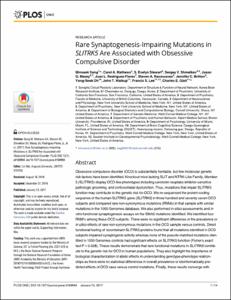Full metadata record
| DC Field | Value | Language |
|---|---|---|
| dc.contributor.author | Song, Minseok | - |
| dc.contributor.author | Mathews, Carol A. | - |
| dc.contributor.author | Stewart, S. Evelyn | - |
| dc.contributor.author | Shmelkov, Sergey V. | - |
| dc.contributor.author | Mezey, Jason G. | - |
| dc.contributor.author | Rodriguez-Flores, Juan L. | - |
| dc.contributor.author | Rasmussen, Steven A. | - |
| dc.contributor.author | Britton, Jennifer C. | - |
| dc.contributor.author | Oh, Yong-Seok | - |
| dc.contributor.author | Walkup, John T. | - |
| dc.contributor.author | Lee, Francis S. | - |
| dc.contributor.author | Glatt, Charles E. | - |
| dc.date.available | 2017-06-29T08:07:06Z | - |
| dc.date.created | 2017-04-10 | - |
| dc.date.issued | 2017-01 | - |
| dc.identifier.issn | 1932-6203 | - |
| dc.identifier.uri | http://hdl.handle.net/20.500.11750/2050 | - |
| dc.description.abstract | Obsessive compulsive disorder (OCD) is substantially heritable, but few molecular genetic risk factors have been identified. Knockout mice lacking SLIT and NTRK-Like Family, Member 5 (SLITRK5) display OCD-like phenotypes including serotonin reuptake inhibitor-sensitive pathologic grooming, and corticostriatal dysfunction. Thus, mutations that impair SLITRK5 function may contribute to the genetic risk for OCD. We re-sequenced the protein-coding sequence of the human SLITRK5 gene (SLITRK5) in three hundred and seventy seven OCD subjects and compared rare non-synonymous mutations (RNMs) in that sample with similar mutations in the 1000 Genomes database. We also performed in silico assessments and in vitro functional synaptogenesis assays on the Slitrk5 mutations identified. We identified four RNM's among these OCD subjects. There were no significant differences in the prevalence or in silico effects of rare non-synonymous mutations in the OCD sample versus controls. Direct functional testing of recombinant SLITRK5 proteins found that all mutations identified in OCD subjects impaired synaptogenic activity whereas none of the pseudo-matched mutations identified in 1000 Genomes controls had significant effects on SLITRK5 function (Fisher's exact test P = 0.028). These results demonstrate that rare functional mutations in SLITRK5 contribute to the genetic risk for OCD in human populations. They also highlight the importance of biological characterization of allelic effects in understanding genotype-phenotype relationships as there were no statistical differences in overall prevalence or bioinformatically predicted effects of OCD case versus control mutations. Finally, these results converge with others to highlight the role of aberrant synaptic function in corticostriatal neurons in the pathophysiology of OCD. © This is an open access article, free of all copyright, and may be freely reproduced, distributed, transmitted, modified, built upon, or otherwise used by anyone for any lawful purpose. The work is made available under the Creative Commons CC0 public domain dedication. | - |
| dc.language | English | - |
| dc.publisher | Public Library of Science | - |
| dc.title | Rare Synaptogenesis-Impairing Mutations in SLITRK5 Are Associated with Obsessive Compulsive Disorder | - |
| dc.type | Article | - |
| dc.identifier.doi | 10.1371/journal.pone.0169994 | - |
| dc.identifier.scopusid | 2-s2.0-85009460359 | - |
| dc.identifier.bibliographicCitation | PLoS ONE, v.12, no.1 | - |
| dc.description.isOpenAccess | TRUE | - |
| dc.subject.keywordPlus | BEHAVIORS | - |
| dc.subject.keywordPlus | FAMILY | - |
| dc.subject.keywordPlus | MANAGemENT | - |
| dc.subject.keywordPlus | Mice | - |
| dc.subject.keywordPlus | Mouse | - |
| dc.subject.keywordPlus | OCD | - |
| dc.subject.keywordPlus | VARIANTS | - |
| dc.citation.number | 1 | - |
| dc.citation.title | PLoS ONE | - |
| dc.citation.volume | 12 | - |
- Files in This Item:
-

10.1371_journal.pone.0169994.pdf
기타 데이터 / 1.8 MB / Adobe PDF download
- Appears in Collections:
- Department of Brain Sciences Molecular Psychiatry Lab 1. Journal Articles



